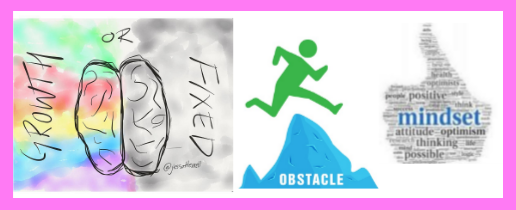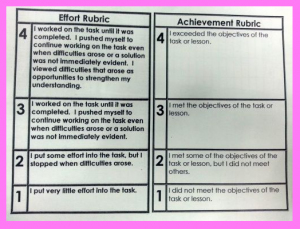


What research has to say about reinforcing effort:
- Not all students realize the impact of effort.
- Students can change their beliefs on the importance of effort.
Classroom Practices
- Explicit practices
- Teachers share stories of how effort carried the day when success did not seem imminent
- Share examples (videos) from famous people who triumphed through effort
- Share examples of effort from famous stories
- Students recall times when they prevailed through effort
- Use rubrics to track effort and achievement:

- Ask students to see correlation between effort and achievement variables
- Ask students to reflect on what they learned about effort
- Graph effort and achievement data
- Achievement vs Effort
- Achievement vs Time
- Effort vs Time
- Have students use graphs to notice patterns in their effort and achievement
What Research has to say about Providing Recognition:
- Rewards do not necessarily have a negative effect on intrinsic motivation
- Worst effect – giving praise for easy tasks can undermine achievement
- Reward is most effective when it is contingent on reaching known performance standards
- Abstract symbolic recognition is more effective than tangible rewards
- Tangible awards = physical prizes, candy
- Verbal praise is effective
- Abstract rewards = recognition for reaching a performance standards
- Tangible awards are still effective when tied to performance standards
Classroom practices related to Recognition:
- Personal Best Honor Roll – students who met individual target goals made this honor roll regardless of whether or not they qualified for absolute grade-based honor roll
- Pause, prompt and praise
- Pause students in work
- Prompt – have supportive conversation on how to improve work
- Praise – After some time and evidence of improvement, congratulate student on their new found success
- Symbolic signs of recognition
- Stickers, stamps, ..
- Make sure these tokens are given for meeting performance standards to create positive or no impact on intrinsic motivation

Teaching about the importance of effort relates to building growth versus fixed mindsets in students. Showing students how their efforts tie to results by tracking rubric stores and through recognition could reinforce beliefs that tie effort to success.

Preparation Steps
- Gather stories (articles, videos) about people who triumphed through effort
- Gather goal setting and tracking tools such as the Effort & Achievement Rubric (see above)
- Design lessons on the importance of effort and its connection to external results (achievements) and internal results (brain development)
Early Implementation Steps
- Implement lessons about importance of effort – incorporate model stories, discussions, and opportunities for students to tie lessons to their own lives
- Use Effort & Achievement Rubric and a Task chart to record effort and achievement scores daily over a period of time
- Create summary graphs of effort and achievement shorts: achievement vs effort, achievement vs time, effort vs time
- Have students identify and reflect upon patterns in summary charts
Advanced Implementation Steps
- Ask students what strategies and practices do they want to incorporate into their daily habits and routines as a result of achievement / effort tracking
- Experiment with different ways for recognizing student effort
- Use student feedback to identify most effective ways for recognizing student work – incorporate these into classroom routines

- Agency articles
